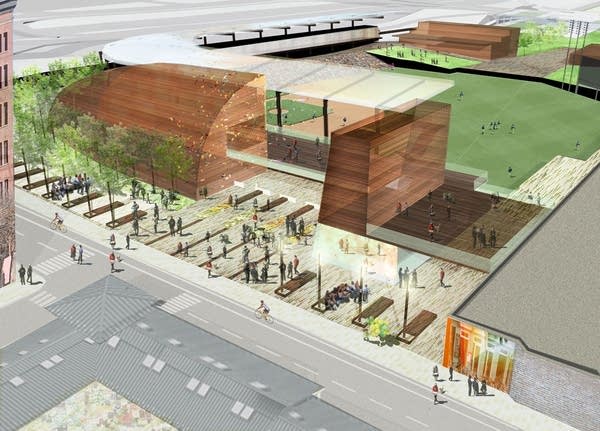St. Paul Saints mount push for Lowertown ballpark
Go Deeper.
Create an account or log in to save stories.
Like this?
Thanks for liking this story! We have added it to a list of your favorite stories.

St. Paul's Midway stadium has a unique feature that few other ballparks probably envy.
It's sinking.
The home of the St. Paul Saints minor league baseball team was built in 1982. Every summer, groundskeepers have to fill in the outfield where the ground is subsiding. It doesn't have enough showers for two full teams and it was built before the Americans with Disabilities Act.
That's a sore spot for Saints owner and baseball impresario Mike Veeck.
Turn Up Your Support
MPR News helps you turn down the noise and build shared understanding. Turn up your support for this public resource and keep trusted journalism accessible to all.
"Most importantly my old man, with a wooden leg, a gimp, he couldn't see a ball game here," Veeck said. "There's just a million reasons this building doesn't work."
Veeck revived St. Paul's minor league Saints back in 1993, hoping to offer a low-cost alternative to the Minnesota Twins. But Veeck said it's the state's NHL team that he's up against.
"The Xcel Center made our lives difficult," he said. "Because you can go to the restroom, buy a beer and be back at your seat in under 6 minutes. Which we timed at a Billy Joel concert. And people notice the efficiencies now. Where we used to be able to shut down the men's room and the ladies could use it because of inadequate — that's not sexy any more."
The alternative the Saints and St. Paul officials are proposing is a new, $50 million downtown stadium, butting up against the St. Paul's Farmer's Market in Lowertown. It would have about 7,500 seats.
Backers say it would put a ballpark on either end of the Central Corridor light rail line and build on the revitalization of the oldest, eastern part of downtown St. Paul.
They say years of sellouts point to the popularity of the team and its stadium.
And it isn't just the Saints that fill the stands. Midway Stadium is also home to Hamline University's ball team and a host of amateur and youth teams.
Gail Kalata is a volunteer with American Legion baseball in St. Paul. Her division plays about 90 games in a five-week season, many of them at the existing Midway stadium.
"Because of the shortage of lighted fields, and other facilities available to us, we do really count on this facility," Kalata said. "Without being able to schedule double-headers here, during our regular league season, there's no way that we could actually get all of those games in."
City officials say that school and amateur teams from Austin to Duluth have played at Midway in tournaments and league play and would play in the new ballpark.
Billy Peterson, who once coached both Paul Molitor and Joe Mauer, said its part of what's made St. Paul a baseball hotbed.
"We have always been very good in baseball," Peterson said. "We have produced a lot of major league players, a lot of college players. And I think the role of a Midway Stadium is the fact that we can play on a top notch facility. A lot of our high school fields, and especially a lot of our recreation fields, are just not conducive to good quality baseball."
He and others are asking lawmakers for $20 million in taxpayer money to help build a new stadium downtown.
But Republicans say the midst of a historic state budget crisis is no time to be thinking about bonding for luxuries like minor league baseball. Many have voiced opposition to the entire bonding bill proposed by DFL Gov. Mark Dayton, which includes a new Saints stadium.
"I like the ballpark for the Saints, but we have to find a way to do it that makes sense," said Rep. Larry Howes, R-Walker, who chairs the House Capital Investment Committee. "If you look at Minneapolis, they've got Target Center, they've got the Twins stadium, they've got the Metrodome so far, and St. Paul's just got Xcel. So, maybe it's time St. Paul got something."
Like other Republicans, though, Howes says this may not be the time.
"I'm still sticking to my guns that we won't have a real bonding bill until next year," Howes said.
Even if the state eventually does kick in money, the city and team would still have to come up with another $25 million to build the ballpark.
Dear reader,
Political debates with family or friends can get heated. But what if there was a way to handle them better?
You can learn how to have civil political conversations with our new e-book!
Download our free e-book, Talking Sense: Have Hard Political Conversations, Better, and learn how to talk without the tension.





